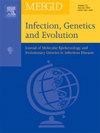Molecular epidemiology of West Nile Virus in raptors, Connecticut, USA, 2022: A case series with whole genome sequencing and phylogenetic analysis
IF 2.6
4区 医学
Q3 INFECTIOUS DISEASES
引用次数: 0
Abstract
West Nile virus (WNV), a mosquito-borne flavivirus, circulates in an enzootic cycle between birds and mosquitoes, with raptors serving as key amplifying hosts. Despite their importance in WNV surveillance, complete genome sequences from raptors remain limited. This study aimed to investigate the genetic diversity and evolutionary history of WNV in raptors from Connecticut, USA. Samples were collected in 2022 from the brain tissue of deceased red-tailed hawks, red-shouldered hawks, Cooper's hawks, a peregrine falcon, and American crows. Complete protein-coding sequences (CDSs) of 19 WNV isolates were obtained using multiplex tiling reverse transcription polymerase chain reaction (RT-PCR) developed in this study and Illumina iSeq100 sequencing. Phylogenetic analyses revealed our sequences were grouped into two monophyletic clusters and two singletons within lineage 1, showing genetic similarities to WNV strains detected in mosquitoes in New York (2012–2015) rather than earlier strains from Connecticut (1999–2008). Bayesian analysis indicated at least four independent introductions, with the estimated time to the most recent common ancestor (tMRCA) for Clusters 1 and 2 in April 2009 and February 2010, respectively. The mean substitution rate was 4.30 × 10−4 substitutions/site/year. All sequences contained the T249P mutation in NS3, which has been linked to reduced virulence in avian models. These findings provide valuable reference data for future WNV genomic surveillance studies, emphasizing the role of raptors as sentinel species and the need for ongoing genomic surveillance to monitor WNV evolution, transmission, and potential public health risks.
西尼罗病毒在美国康涅狄格州猛禽的分子流行病学:全基因组测序和系统发育分析的病例系列。
西尼罗河病毒(WNV)是一种由蚊子传播的黄病毒,在鸟类和蚊子之间以地方病循环传播,猛禽是主要的扩增宿主。尽管它们在西尼罗河病毒监测中很重要,但迅猛龙的完整基因组序列仍然有限。本研究旨在调查美国康涅狄格州猛禽西尼罗河病毒的遗传多样性和进化历史。2022年,研究人员从死去的红尾鹰、红肩鹰、库珀鹰、游隼和美国乌鸦的脑组织中收集了样本。利用本研究建立的多重叠片反转录聚合酶链反应(RT-PCR)和Illumina iSeq100测序技术,获得了19株西尼罗河病毒分离株的完整蛋白编码序列(CDSs)。系统发育分析显示,我们的序列在谱系1中分为两个单系簇和两个单系簇,显示与在纽约(2012-2015年)而不是在康涅狄格州(1999-2008年)的蚊子中检测到的西尼罗河病毒菌株具有遗传相似性。贝叶斯分析表明,聚类1和聚类2至少有4次独立的引种,聚类1和聚类2到最近共同祖先(tMRCA)的时间分别为2009年4月和2010年2月。平均取代率为4.30 × 10-4次/位点/年。所有序列都包含NS3的T249P突变,这与鸟类模型中毒性降低有关。这些发现为未来的西尼罗河病毒基因组监测研究提供了有价值的参考数据,强调了猛禽作为哨点物种的作用,以及持续进行基因组监测以监测西尼罗河病毒的进化、传播和潜在的公共卫生风险的必要性。
本文章由计算机程序翻译,如有差异,请以英文原文为准。
求助全文
约1分钟内获得全文
求助全文
来源期刊

Infection Genetics and Evolution
医学-传染病学
CiteScore
8.40
自引率
0.00%
发文量
215
审稿时长
82 days
期刊介绍:
(aka Journal of Molecular Epidemiology and Evolutionary Genetics of Infectious Diseases -- MEEGID)
Infectious diseases constitute one of the main challenges to medical science in the coming century. The impressive development of molecular megatechnologies and of bioinformatics have greatly increased our knowledge of the evolution, transmission and pathogenicity of infectious diseases. Research has shown that host susceptibility to many infectious diseases has a genetic basis. Furthermore, much is now known on the molecular epidemiology, evolution and virulence of pathogenic agents, as well as their resistance to drugs, vaccines, and antibiotics. Equally, research on the genetics of disease vectors has greatly improved our understanding of their systematics, has increased our capacity to identify target populations for control or intervention, and has provided detailed information on the mechanisms of insecticide resistance.
However, the genetics and evolutionary biology of hosts, pathogens and vectors have tended to develop as three separate fields of research. This artificial compartmentalisation is of concern due to our growing appreciation of the strong co-evolutionary interactions among hosts, pathogens and vectors.
Infection, Genetics and Evolution and its companion congress [MEEGID](http://www.meegidconference.com/) (for Molecular Epidemiology and Evolutionary Genetics of Infectious Diseases) are the main forum acting for the cross-fertilization between evolutionary science and biomedical research on infectious diseases.
Infection, Genetics and Evolution is the only journal that welcomes articles dealing with the genetics and evolutionary biology of hosts, pathogens and vectors, and coevolution processes among them in relation to infection and disease manifestation. All infectious models enter the scope of the journal, including pathogens of humans, animals and plants, either parasites, fungi, bacteria, viruses or prions. The journal welcomes articles dealing with genetics, population genetics, genomics, postgenomics, gene expression, evolutionary biology, population dynamics, mathematical modeling and bioinformatics. We also provide many author benefits, such as free PDFs, a liberal copyright policy, special discounts on Elsevier publications and much more. Please click here for more information on our author services .
 求助内容:
求助内容: 应助结果提醒方式:
应助结果提醒方式:


